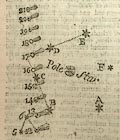





SIR,
TO compleat your Account of the Comet, I have sent you the following Sketch, which, if you think it worthy a Place in your Magazine, please to get it engraved in due Proportion. Your last from Mr Wright (by whose Oversight I cannot pretend to say) is vastly wide from the Determination he draws from it.


The small Stars 5 and 6 are the 5th and 6th without Form in Tycho Brahe's Catalogue of the Lesser Bear, both of the 6th Magnitude; with which two Stars the Head of the Comet form'd an equilateral Triangle March the 12th about 9 at Night.
That Star mark'd A is the 2d in the Bear's Tail, the other five, viz B, C, D, E, F, (which together with (A) form a Hexagon, not very irregularly, about the Pole Star) are neither in Tycho's Catalogue, nor that more copious one of our Countryman Mr Flamstead: B C and E I find in Hevetius's Description of Cepheus, but D and F, the latter being a very small one of the 7th or 8th Magnitude, I can find no Account of: The Places of the Comet mark'd 12, 13, 14, &c. are its Places the respective Nights in March. The 13th, when in a Line with the two Stars, its Tail fell directly upon the Star B: At its nearest Approach to the Pole Star, viz. March the 16th, its Distance was scarcely 3 1/2 Degrees of a Great Circle. My Observations were made about 9 or 10 at Night. I was not very curious as to Minutes, the precise Time being of little Use in this manner of observing. Saturday the 20th being somewhat cloudy, the Comet appear'd distinctly thro' the Breaks, but the 21st it was scarcely visible to an unarm'd Eye, tho' with a Telescope it appeared very distinct; after which Night, cloudy Weather setting in, I saw it no more, and had the Air continued clear, I presume it would have quite disappeared in a few Days, not far from the Place of my last Observation. I have not troubled you with its Longitude and Latitude at each Observation, that being easily obtained from the Scheme, and correct Places of the Stars.
I am, Sir, your humble Servant,
Friestone April 4, 1742
Edmund Weaver.


 Gents Mag 1742 p.210
Gents Mag 1742 p.210